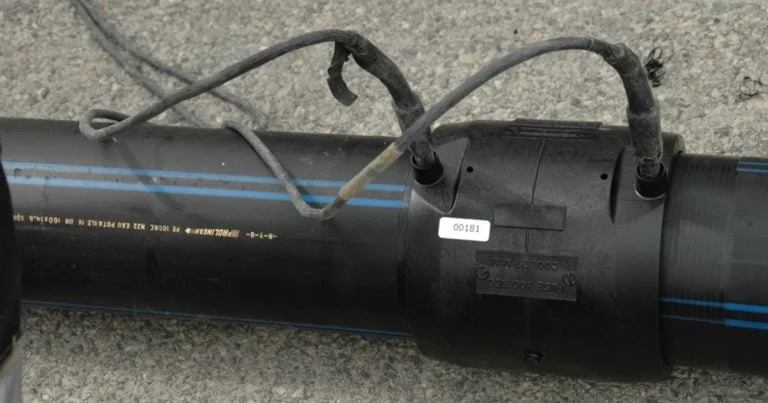The history of PE materials used in pressurised pipework is typified by the continuous development of the resins and pipes.
Naturally, the first thing to look at is a pipe’s ability to withstand pressure; PE materials have gradually increased from PE32 to PE100, allowing them either to be used for higher pressure applications or to be made with thinner walls without affecting performance. The current consensus is that medium density PE80 is the better solution for smaller diameters due to its greater flexibility, while PE100 is more suitable for larger diameters.
However, there is another characteristic that must not be overlooked: resistance to slow crack growth, which has also seen developments that were no less spectacular.
While MRS can be used to dimension the pipework according to the service pressure, resistance to slow crack growth (SCG) gives an indication of the pipe’s performance over time and its capacity to withstand ‘fragile’ breaks.
The pre-notched pipes are tested using the standardised Notch Pipe Test or NPT, carried out under pressure at 80°C. The performance of the pipes has progressively increased from a few dozen hours for the first generations of PE to 1000 / 3000 hours for the current PE100 pipes, and over 8760 hours (one year) in the case of PE100-RC pipes which have opened the way to new applications.
This major evolution in PE resins has been made possible by the combined use of perfected catalyzation systems, advanced manufacturing processes and more often than not, the replacement of butene with hexene as the co-monomer to create much stronger and more effective binding molecules between the HDPE crystalline zones on the molecular scale, and thereby keep the macromolecular structure intact even when it is subjected to extreme stresses.
Figure 1: The role binding molecules play in the structure of PE resins
In practice, this strengthening endows the pipes with a much greater ability to withstand the mechanical attacks to which they may be subjected during their service life, such as notching to their outer surface and resisting sharp point loads created by stones.
As a result, PE100-RC can be installed under far harsher conditions than conventional PE100 pipes, including:
- Trenchless laying using directed drilling amongst other techniques, where there is a risk of creating notches in the outer surface of the pipe.
- Installation in open trenches with no sand bed where the extracted earth is reused directly as backfill; This type of installation not only saves a considerable amount of time compared to conventional methods, it can also produce substantial savings in terms of total installation cost of around 20% to 50%, easily covering the extra cost of the PE100-RC pipes.
Beyond the economic aspect, the environmental benefits are, of course, very much in evidence: no need for lorries to bring special fill material to the site and no need to dispose of the unusable material removed from the trenches.
It is not difficult to see why these next-generation pipes are being rapidly taken up in Europe and the rest of the world. It is estimated that in Germany, the ‘cradle’ of PE100-RC, 20% to 30% of the construction work is currently using this type of pipe and it is probable that the use of PE100-RC will soon overtake that of conventional PE100. In France too, use of the new materials is seeing steady growth.
Nevertheless, a decisive element in the uptake of this process rests on the development of reliable and reproducible international testing methods tailored to the performance of these resins: tests to characterise a pipe’s resistance to slow crack growth are currently slow and not well suited to the task as they were developed to test previous generations of resin: Both the ISO 13479 ‘Notch Pipe Test’ and the ‘Point Load Test’ developed in Germany by Hessel Laboratories can take up to a year to complete, making them unsuitable for regular use. However, the work currently being done by the special ISO working group looking into the problem seems promising.
In the slightly longer term and to achieve full recognition, this new category will need to be incorporated into existing product standards such as EN12201 and EN1555, then into the Certification Mark regulations such as the NF114 Mark in France. Currently, PE100-RC is only defined via local but similar technical specifications such as the PAS1075 specification in Germany and the technical notices issued by the CSTB in France.
Christophe Salles, Borealis


